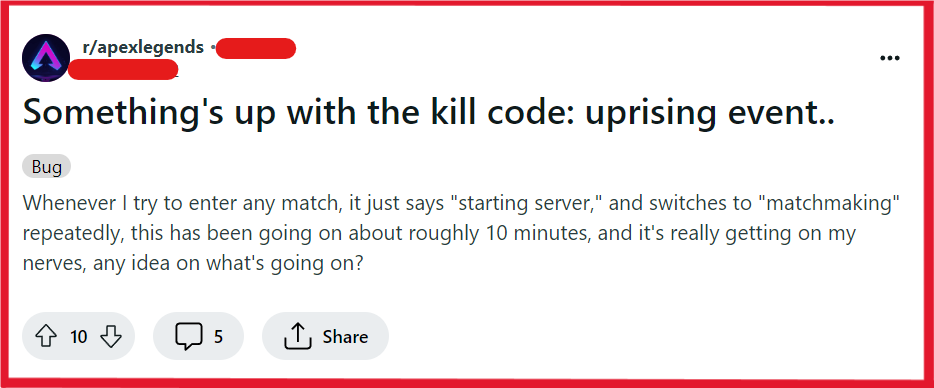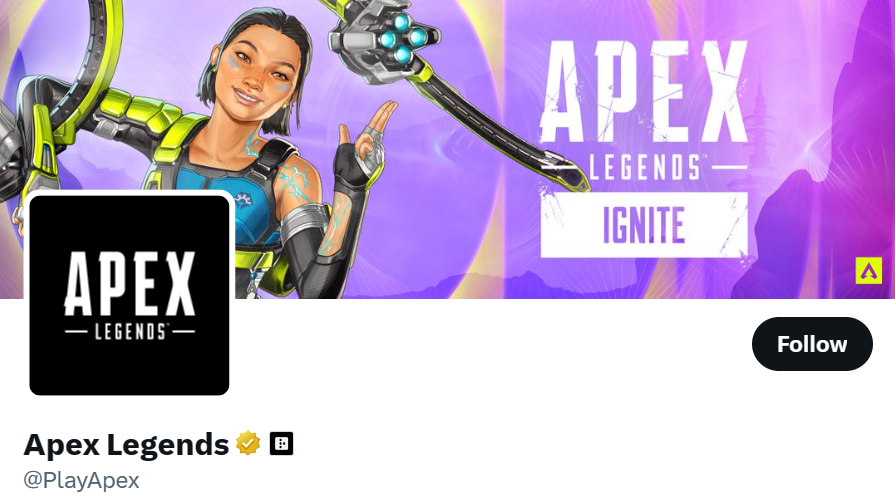Are you looking to solve the frustrating issue of Apex Legends Kill Code UPRISING matchmaking not working?
Whether you’re a seasoned player or just starting out, encountering matchmaking problems can be a real buzzkill.
In this blog, we’ll explore effective solutions to get you back into the action-packed world of Apex Legends.
How To Fix Apex Legends Kill Code UPRISING Matchmaking Not Working?

To fix Apex Legends kill code uprising matchmaking not working, you can check server status, restart Apex Legends and your device, and check your internet connection. Additionally, you can adjust your data centre, update Apex Legends, and verify Apex Legends game files.
1. Check Server Status Of Apex Legends

Before attempting any fixes, it’s crucial to know if the problem is on your end or if it’s a server-side issue.
Apex Legends often updates their Twitter account with server status and event-related issues.
If there’s an outage or maintenance, you’ll typically find information there.
2. Restart Apex Legends And Your Device
A simple restart can sometimes fix minor glitches. Close Apex Legends and restart your gaming device.
This can clear temporary files and fix errors that may have occurred during the initial game start-up.
For PC:
- Exit Apex Legends by closing the game window or using the in-game menu to quit.
- Shut down your PC through the Start menu.
- Wait for a few seconds, then turn your PC back on and relaunch Apex Legends.
For Xbox:
- Press the Xbox button to open the guide menu.
- Select Apex Legends and press the Menu button on your controller.
- Choose “Quit” to fully close the game.
- Restart your Xbox by holding the Xbox button on the console for 10 seconds until it shuts down, then turn it back on.
For PlayStation:
- Press the PS button to open the quick menu.
- Highlight Apex Legends, press the Options button on your controller, and select “Close Application.”
- Turn off your PlayStation by holding the power button until you hear two beeps, then turn it back on after a few seconds.
3. Check Your Internet Connection
A stable internet connection is essential for online matchmaking.
Test your connection for any issues and restart your router or modem if necessary.
You can also try connecting to a different network to see if that resolves the issue.
- Perform a network test on your device to check for connectivity issues.
- If the test indicates a problem, restart your router or modem by unplugging it for about 30 seconds and then plugging it back in.
- Once your internet connection is restored, try connecting to a different network if the issue persists to determine if the problem is network-specific.
4. Adjust Your Data Center
Sometimes, switching to a different data center can improve matchmaking.
- Launch Apex Legends and wait on the title screen for 60 seconds.
- Press the button indicated on the screen to access the Data Center (this may vary depending on the platform).
- A list of data centers will appear, showing ping times and packet loss.
- Select a data center with the lowest ping and packet loss percentages for better matchmaking performance.
5. Update Apex Legends
Ensure that Apex Legends is updated to the latest version. Game updates can fix bugs and improve performance.
Check your platform’s game library or store for any available updates.
For PC (Origin or Steam):
- Open your game library in the Origin or Steam client.
- If an update is available for Apex Legends, it should be indicated next to the game.
- Follow the prompts to download and install the update.
For Xbox:
- Press the Xbox button and go to “My Games & Apps.”
- Select “Updates” from the sidebar.
- If an update for Apex Legends is available, it will appear in this section.
- Select Apex Legends and choose “Update” to start the process.
For PlayStation:
- Highlight Apex Legends on the home screen or in your game library.
- Press the Options button, and then select “Check for Update.”
- If an update is available, follow the on-screen instructions to download and install it.
6. Repair Apex Legends Game Files
If you’re playing on PC, use the repair tool in the Origin or Steam client to check for corrupted or missing game files.
This process will replace any problematic files without affecting your game progress.
On Origin:
- Open the Origin client and go to “My Game Library.”
- Right-click on Apex Legends.
- Select “Repair” from the drop-down menu.
- Wait for the process to complete and try launching the game again.
On Steam:
- Open the Steam client and navigate to the “Library” section.
- Right-click on Apex Legends.
- Select “Properties” from the context menu.
- Go to the “Local Files” tab.
- Click on “Verify Integrity of Game Files.”
- Wait for the validation process to complete before trying to play.
7. Uninstall And Reinstall Apex Legends
If none of the above steps work, consider uninstalling and then reinstalling Apex Legends.
This can be a time-consuming process, but it can also resolve persistent issues by providing a clean install of the game files.
On PC (Origin or Steam):
- Open the client (Origin or Steam).
- Navigate to the game library.
- Right-click on Apex Legends and select “Uninstall.”
- Follow the on-screen prompts to remove the game.
- Once uninstalled, restart your client.
- Search for Apex Legends in the store and select “Install.”
- Follow the installation instructions.
On Xbox:
- Go to “My Games & Apps” from the home screen.
- Highlight Apex Legends and press the Menu button on your controller.
- Select “Uninstall.”
- Confirm the action.
- Once uninstalled, go to the Xbox Store and search for Apex Legends.
- Select “Install” to re-download the game.
On PlayStation:
- From the home screen, navigate to the Apex Legends icon.
- Press the Options button on your controller and select “Delete.”
- Confirm the deletion.
- Go to the PlayStation Store and find Apex Legends.
- Select “Download” to reinstall the game.
8. Contact EA Customer Support

If you’ve tried all these steps and still can’t resolve the issue, it’s time to contact EA’s customer support.
They can provide more in-depth troubleshooting or inform you about any ongoing issues that haven’t been publicly announced yet.

